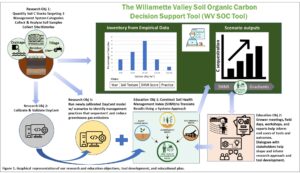Project Overview
Commodities
- Agronomic: grass (misc. perennial)
Practices
- Natural Resources/Environment: carbon sequestration
Proposal abstract:
In addition to growing over two-thirds of the nation’s cool-season grass seed, cropping systems in the Willamette Valley (WV) produce a diverse rotation of over 250 seed commodities for forage, food, and cover cropping applications. Climate change impacts in the region are predicted to have transformational effects on agriculture. Loss of winter snowpack, reduced summer stream flows, increased temperatures, and plant water demands are phenomena that have already been observed and are expected to worsen over the century. Some farmers are responding to a changing climate by adopting conservation practices that reduce tillage and return post-harvest residues to increase soil organic carbon (C), water-holding capacity, and overall system resiliency. Although these practices are hypothesized to increase soil C stocks and soil health metrics, only two studies in the WV (6-9 years in duration) have attempted to link agricultural practices with C storage increases and neither observed substantial increases in soil C. These results are not surprising, given that changes in C stocks due to management shifts can take decades to manifest. Furthermore, with significant interannual variation in crop rotations and other management practices at the local and regional scale, it is challenging to decouple field to field variation from management impacts. Simultaneously, statewide initiatives to reduce C emissions are expected to incentivize agricultural practices that increase soil C. As legislative action to regulate C emissions emerges, quantifying the current status of C storage in grass seed systems and identifying potential management strategies for increased C capture, will help inform and guide stakeholders in supporting this critical ecosystem service.
To equip farmers, crop advisors, policy makers, and conservation planners with the best science to date, we propose a combination of field soil C monitoring data and a process-based modeling effort to improve estimates of soil C dynamics in WV seed production systems. In consultation with our grower collaborators, we have identified three key management practices with potential C benefits. We will leverage and expand on previous work in the area to achieve our research goals to develop a soil C inventory for the WV grass seed industry and identification of management practices for climate mitigation and farm resiliency using both measured and modeled data (Figure 1). Our educational goals and outreach efforts will utilize multiple dissemination pathways such as field days, extension reports and manuscripts, and the WV Soil Organic Carbon Tool. This tool will host a dynamic and expandable soil C inventory that can build over time, a suite of factsheets and interpretative guides, and modeled scenario outputs to help users predict how management practices implemented on their farm may impact C sequestration and greenhouse gas emissions. Soil C workshops will be organized to provide training. Based on our findings, we aim to demonstrate the important role that Oregon seed production systems play in mitigating climate change and overall farm resilience. Initially, we will focus on C sequestration potential, but intend to build a flexible platform to include other soil health metrics over time.
Project objectives from proposal:
Research Objectives:
- Quantify soil C stocks for the grass seed industry in the WV, OR with an emphasis on systems differing in subsurface drainage, residue, and tillage management practices.
- Calibrate and validate the DayCent model (a biogeochemical model used to predict carbon sequestration and greenhouse gas fluxes in agricultural systems) using data generated in objective 1.
- Identify which management practices support the greatest C sequestration potential using sensitivity analysis from a suite of DayCent simulations.
Education Objectives
- Translate C results into a decision support tool to help growers understand how management impacts C storage on their farms; and,
- Increase industry wide growers’ knowledge of the factors that affect soil C sequestration potential in WV grass seed systems.
